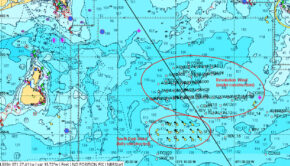Lessons of a Bermuda Race skipper
Published on September 22nd, 2015
The Newport Bermuda Race entry process may seem daunting. But as this report by a former first-timer shows, it’s not all that difficult when done with care. Philip Dickey, the author, skippered his Swan 46 Flying Lady in the 2012 race (they raced again in 2014)…
 I learned valuable lessons. Most important, I learned that the safety and health of the crew are a skipper’s most important concerns. You are unlikely to win your class in your first race, but you are certain to face awesome responsibility for your crew and their loved ones as you race your boat over 600 miles offshore on the way to Bermuda.
I learned valuable lessons. Most important, I learned that the safety and health of the crew are a skipper’s most important concerns. You are unlikely to win your class in your first race, but you are certain to face awesome responsibility for your crew and their loved ones as you race your boat over 600 miles offshore on the way to Bermuda.
Not only is the Newport Bermuda Race the oldest and arguably the most prestigious of the popular offshore races open to amateurs, it is especially challenging because it takes you far offshore and out of range of rescue helicopters and Coast Guard vessels. This race is the Everest of offshore racing. Most of the Bermuda Race is beyond coastal helicopter range, so if you need outside assistance beyond advice by satellite phone, you likely will need to call a commercial vessel to rescue you, your crew, and your boat.
The best way to avoid having to be rescued is to engage in meticulous preparation. To prepare for this race you must do three things: Prepare the boat for safety, prepare the crew for safety, and prepare the skipper for the responsibility for the health, in addition to the safety, of the crew.
Each experienced skipper will have his or her way of doing these things. But for the first-time skipper, based upon my experience, I have three recommendations:
(1) Follow to the letter the Bermuda Race Organizing Committee (BROC) protocol, instructions, and timeline as you prepare for boat inspection. (2) Insist that all your crew attend a US Sailing certified Safety at Sea Seminar before the race—preferably together, as a team. (3) And I strongly recommend that you recruit a medical professional for your crew. This may be a doctor, a physician’s assistant, or a qualified nurse. If you do these three things, you and your crew will be as prepared as you can be for this challenging race.
1. Prepare for Inspection
The Newport Bermuda Race website (www.BermudaRace.com) contains the information you need to organize a plan for preparation of your boat for safety. The race documents, race chairman’s bulletins, updates, and much more are posted on the race’s Official Notice Board on the home page.
The race is an International Sailing Federation (ISAF) Category 1 race, which means that you must prepare for long periods at sea without the possibility of rescue. The Newport Bermuda Race Safety Requirements are based on the U.S. Sailing Safety Equipment Requirements (SERs). This is a plain-language, compact alternative to the ISAF Offshore Special Regulations (with the addition of the race’s special prescriptions). The NBRSRs lay out what’s required to pass inspection. If you see 20-foot waves and 30-knot winds in the Gulf Stream, as we did in 2012, you will be glad that you prepared your boat according to these stringent guidelines, and you will sleep soundly when off watch.
Anticipate a thorough boat inspection. Have everything ready for the inspector, including documents. Expect the inspector to be formal but cordial. Understand that he is your friend, there to assess your readiness for the race. It is in both your and the BROC’s interest that your boat can complete the race without outside assistance. Get everything done early. Push your sailmaker to submit measurements of new sails so you can get updated ORR certificates promptly.
Be in the water in April so you can get your inspection done in early May. You should not have to worry yourself about inspection later on, when you need to be concentrating on the crew, customs and immigration, delivery issues, and Gulf Stream navigation.
2. Attend a Certified Safety at Sea Seminar
As a first-time skipper, you face three challenges with respect to the crew structure. All three are addressed at safety seminars. First, you want your crew to take preparation seriously. There is nothing like a safety seminar to focus a crew’s attention. If you want to have eight people help you trace every hose leading to a through hull, make sure they attend a safety seminar. Second, even if your crew has more offshore experience than you do, you as owner are legally responsible for the boat and crew. More experienced sailors must follow your orders. A safety seminar emphasizes leadership and crew structure.
The Newport Bermuda Race’s own safety seminar will be held Mar 19-20, 2016 in Newport. Other safety seminars are listed on US Sailing’s Safety page.
As you put together your first Newport Bermuda Race crew, you may experience crew attrition as the race date approaches. Four of my original crew of ten opted out within three months of the race. None of those dropouts had attended a safety seminar, but every one of those who stayed had attended a seminar. You should probably question the commitment of a sailor who won’t agree to a one-day seminar in the months prior to a major offshore race. Strongly consider replacing anyone who won’t commit.
3. Recruit a Medical Professional
This will be easier than you think. Full disclosure: I am an MD, as were two of my crew in 2012 (we also had a dentist). But other MD friends expressed interest, and several qualified MDs were on the race website’s online crew finder list a couple of weeks before the start. If you can’t recruit an MD, find a physician’s assistant or nurse who has critical care experience.
Why recruit an MD? You may find yourself with sick or injured crew onboard while days away from Bermuda. This happened on Seabiscuit, a J46 in the 2012 race. Ultimately the sick crew became seriously ill and required evacuation by a cruise ship, at significant risk. The evacuation may not have been required had an MD been on board. And as the average age of racing sailors increases, you may find yourself with crew who have diabetes, heart disease, or other chronic illnesses. In my 2012 crew we had two diabetics on medications and two others on powerful blood thinners for heart problems.
It is fair to ask the MD to prepare and pay for an extensive medical kit, one which should exceed requirements and should contain, among other things, IV fluids, medications, and the hardware necessary to administer them. The MDs I know who are looking for a ride would be happy to provide the kit and expertise in exchange for offshore experience.
Two More Lessons
I learned a couple of other key lessons in my first Bermuda Race as skipper. If you want to take an ISAF Category 3 professional sailor with you and allow him to steer, enter the Gibbs Hill or another professional division. And be sure to check with your insurance agent about whether your current policy will cover you for an offshore race. I found out a couple of months before the race that my policy would not provide coverage and I had to change insurers. Check early.
A Newport Bermuda Race is a wonderful adventure for properly prepared boats and crews. I thoroughly enjoyed the skipper experience and had much more fun in 2012 than on the previous two I crewed.
Editor’s Note: Philip Dickey and his crew put their lessons learned to exceptional use during the 2012 Bermuda Race when they powered 25 miles upwind into a rough sea to offer medical assistance fo Seabiscuit. The Bermuda Race Organizing Committee awarded seamanship awards to Dr. Dickey and two other race sailors, Jonathan Green of Seabiscuit and Scott Jackson of Spirit of Bermuda. For more about this incident, see the Bermuda Race Organizing Committee 2012 incident report.









 We’ll keep your information safe.
We’ll keep your information safe.